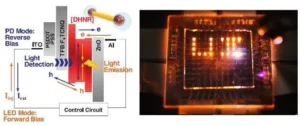A team of researchers lead by Moonsub Shim, a professor of Materials Science and Engineering at the University of Illinois (Urbana-Champaign, IL), is developing a novel type of LED. The so-called nanorod LED is a switchable device that can be a high brightness emitter when in one mode of operation and a visible light detector when in a second mode.
The most recent results by the team are reported in an article entitled “Double-heterojunction nanorod light-responsive LEDs for display applications.” The article appeared in Science, 2017 Feb. 10; 355 (6325): 616-619. A copy of the article is available for purchase here.
The device consists of array of tiny nanorods, each about 50nm long and 6nm in diameter. The nanorods are synthesized in, and can be processed as, solutions. This makes it easy to deposit the materials in a thin film, a necessary step in the creation of the LED array.
“The device includes quantum dots of two different types directly in contact with two different semiconductor materials within the nanorod. One type emits and absorbs visible light. The other two semiconductors control how charge flows through the first material.”
The layered structures in the nanorod can be independently adjusted so as to fine tune both radiative recombinations (useful for LEDs) and efficient charge separation of photo generated carriers. As a result, a single nanorod can be both electroluminescent and generate a photocurrent. Once appropriately layered between electrodes, the nanorods can be arranged into pixels. By changing the applied voltage between a forward bias and a reverse bias, the device can be switched between light emitting and light detecting modes.
The configuration and aspects of the principle of operation of the nanorod LED device are graphically illustrated in the figure below and to the left. A prototype device in one of its modes of operation is illustrated in the figure below and to the right.
A prototype device demonstrated a low turn on voltage (~1.7 V) and a maximum brightness greater than 80,000 cd/m². The device also exhibited low bias and high efficiency at display relevant brightness levels. The researchers report an external quantum efficiency of 8.0% at 1000 cd/m under 2.5 V bias.
The nanorod LEDs are able to quickly switch between emitting and detecting. In fact, the switching rate is three orders of magnitude faster than standard display refresh rates. This is so fast that, to a person viewing the display, it appears to be steadily on. At the same time, the LEDs are also near continuously detecting and absorbing light.
As a demonstration of this dual mode capability, the researcher prototyped a 10×10 array of nanorod LED pixels. The pixels operated as photodetectors when a reverse bias was applied while, in addition and at the same time, a circuit board supplied a forward bias to any pixel detecting incident light. By alternating forward and reverse bias at a sub-millisecond rate, light detecting pixels could be “read out” as they illuminated the array.
Given these capabilities, a display made from nanorod LEDs can be configured to respond to incident light in several different ways.
Applications
In one configuration, a display could automatically adjust brightness in response to ambient light conditions an do so on a pixel-by-pixel basis. Two examples of the use of this capability are as follows:
- Let it be a sunny day. Let a user with a computer tablet based on nanorod LEDs sit outside, under a tree. The sitting area is dappled with patches of sunlight and shade. Where a shadow falls across the display, the shaded pixels will dim. The pixels in direct sunlight will get brighter. By these means, it becomes possible to maintain a uniform contrast across the display.
- The researchers demonstrated pixels that respond to the shadow cast by an approaching finger. “This capability could be integrated into interactive displays that respond to touchless gestures or recognize objects.”
It was also demonstrated that arrays could respond to a laser stylus. “This capability could be the basis of smart whiteboards, tablets or other surfaces for writing or drawing with light.”
Some of these capabilities are demonstrated on a prototype device in a video that can be found at the end of this article.
The researchers also demonstrated that the nanorod LEDs can convert light to electricity, the device responding to light much like a solar cell. Details of the demonstration are reported in the technical article in which the nanorod LEDs were coupled to a supercapacitor.
Perhaps the most intriguing aspect of the new technology is the potential for “nanorod LED displays to interact with each other as large, parallel communication arrays. The communication rate would be slower than device-to-device technologies such as Bluetooth, but such technologies are serial and can send data only one bit at a time. Two nanorod LED arrays facing each other could simultaneously communicate with as many bits as there are pixels in the display.”
The researchers think that nanorod LEDs can become the basis for new and interesting multifunctional display devices, “displays that do something completely different, moving well beyond just displaying information to be much more interactive devices.”
The researchers report that patent applications have been filed for the new technology. The team also report that there is commercial interest in nanorod LED technology.
“All of the demonstrations developed by the researchers were conducted with arrays of red nanorod LEDs. The team is now working on methods to pattern three color displays with red, blue and green pixels, as well as developing means to boost device light-harvesting capabilities by adjusting the composition of the nanorods.” -Arthur Berman
University of Illinois, Moonsub Shim, 217-333-7361, [email protected]

